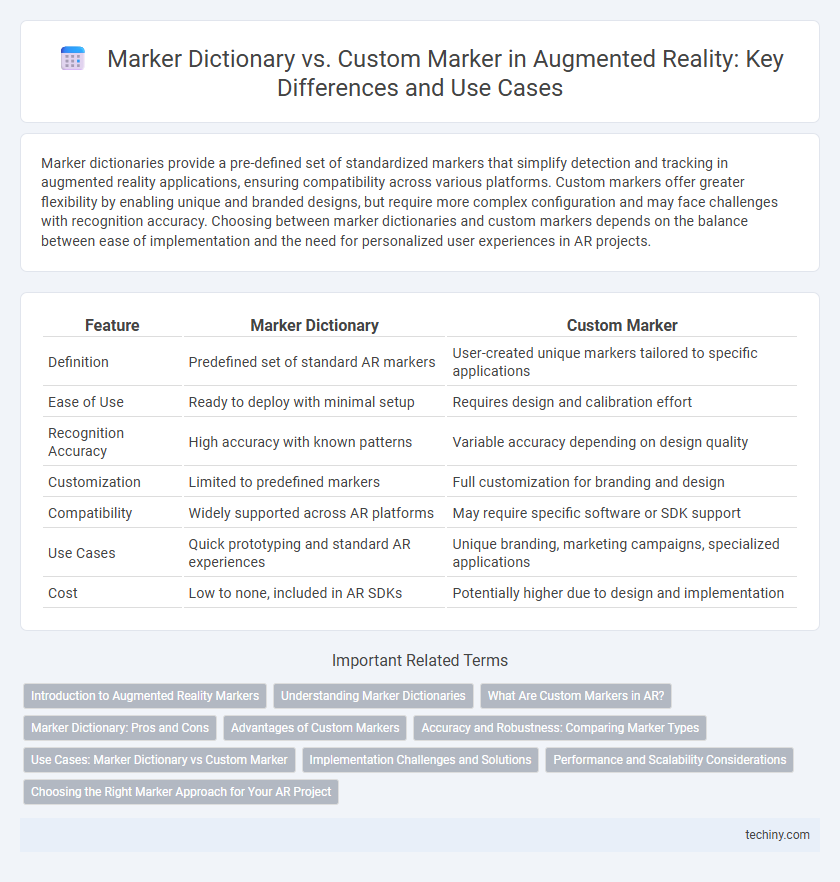Marker dictionaries provide a pre-defined set of standardized markers that simplify detection and tracking in augmented reality applications, ensuring compatibility across various platforms. Custom markers offer greater flexibility by enabling unique and branded designs, but require more complex configuration and may face challenges with recognition accuracy. Choosing between marker dictionaries and custom markers depends on the balance between ease of implementation and the need for personalized user experiences in AR projects.
Table of Comparison
| Feature | Marker Dictionary | Custom Marker |
|---|---|---|
| Definition | Predefined set of standard AR markers | User-created unique markers tailored to specific applications |
| Ease of Use | Ready to deploy with minimal setup | Requires design and calibration effort |
| Recognition Accuracy | High accuracy with known patterns | Variable accuracy depending on design quality |
| Customization | Limited to predefined markers | Full customization for branding and design |
| Compatibility | Widely supported across AR platforms | May require specific software or SDK support |
| Use Cases | Quick prototyping and standard AR experiences | Unique branding, marketing campaigns, specialized applications |
| Cost | Low to none, included in AR SDKs | Potentially higher due to design and implementation |
Introduction to Augmented Reality Markers
Augmented Reality markers serve as visual cues enabling AR devices to recognize and track objects or locations in the physical environment. Marker dictionaries consist of pre-designed, standardized patterns allowing for quick identification and compatibility across multiple AR platforms. Custom markers, in contrast, offer personalized designs tailored to specific applications, enhancing brand identity and improving tracking accuracy in specialized scenarios.
Understanding Marker Dictionaries
Marker dictionaries in augmented reality provide a standardized set of predefined patterns that enhance tracking accuracy and recognition speed across various AR platforms. Unlike custom markers, which require manual design and calibration, marker dictionaries allow developers to leverage tested, optimized codes that reduce false positives and improve robustness in complex environments. Utilizing marker dictionaries also streamlines integration with AR tracking systems like ARKit and ARCore by maintaining consistency in marker identification and supporting scalable multi-marker setups.
What Are Custom Markers in AR?
Custom markers in augmented reality are user-designed visual patterns or images specifically created to trigger AR experiences, differing from standard marker dictionaries that use predefined sets of markers. These personalized markers enhance brand identity and provide unique interaction tailored to specific applications or environments. Creating custom markers involves selecting distinctive shapes, colors, or logos optimized for reliable detection and tracking by AR systems.
Marker Dictionary: Pros and Cons
Marker dictionaries in augmented reality provide a pre-defined set of recognizable patterns, enabling quick and reliable marker detection across diverse applications. Their pros include ease of implementation, consistency in recognition, and broad compatibility with AR software development kits like Vuforia and ARKit. However, limitations arise from lower uniqueness compared to custom markers, leading to potential false positives in complex environments and restricting creative flexibility.
Advantages of Custom Markers
Custom markers in augmented reality offer enhanced flexibility by allowing unique designs tailored to specific applications, improving tracking accuracy and user engagement. They can be optimized for distinct environmental conditions, reducing false positives and increasing detection robustness compared to standard marker dictionaries. Custom markers also enable brand integration and seamless user experiences by aligning AR content with corporate identity and marketing goals.
Accuracy and Robustness: Comparing Marker Types
Marker dictionaries offer high accuracy and robustness due to standardized patterns optimized for reliable detection across various environments. Custom markers can provide tailored designs, but their accuracy often depends on careful calibration and environmental consistency, potentially reducing robustness in diverse conditions. Standardized dictionaries minimize false positives and enhance detection speed, making them preferable for applications requiring consistent performance.
Use Cases: Marker Dictionary vs Custom Marker
Marker dictionaries provide a standardized set of predefined markers ideal for applications requiring consistent recognition across multiple users and devices, such as educational tools or industrial maintenance. Custom markers offer flexibility in design, enabling brands or developers to create unique visual identifiers tailored to specific marketing campaigns or interactive experiences. Choosing between marker dictionaries and custom markers depends on whether the use case prioritizes interoperability and reliability or distinctive branding and personalized interaction.
Implementation Challenges and Solutions
Marker dictionaries offer a standardized set of predefined markers that simplify implementation through consistent detection algorithms, reducing development time and improving reliability in augmented reality applications. Custom markers, while enabling unique and brand-specific designs, present challenges such as requiring extensive training data and fine-tuning algorithms to achieve accurate detection in varied environments. Solutions for these challenges involve leveraging machine learning techniques for robust marker recognition and optimizing image preprocessing to increase reliability across diverse lighting and angles.
Performance and Scalability Considerations
Marker dictionaries in augmented reality offer optimized performance through predefined patterns that enable faster recognition and tracking, reducing computational overhead. Custom markers provide flexibility but may require additional processing power and calibration time, impacting real-time responsiveness and scalability in multi-marker environments. Choosing between marker dictionaries and custom markers depends on the balance of efficiency needs and the complexity of the AR application's marker system.
Choosing the Right Marker Approach for Your AR Project
Selecting the appropriate marker approach for your AR project hinges on the complexity and specificity of your application. Marker dictionaries offer pre-defined, standardized patterns optimized for rapid detection and broad compatibility, ideal for general-purpose AR experiences. Custom markers provide tailored designs that enhance brand identity and tracking accuracy but require more development time and resource investment to implement effectively.
Marker dictionary vs Custom marker Infographic

 techiny.com
techiny.com